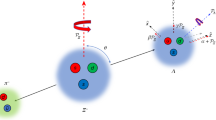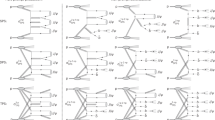Abstract
Particles directly produced at electron–positron colliders, such as the J/ψ meson, decay with relatively high probability into a baryon–antibaryon pair1. For spin-1/2 baryons, the pair can have the same or opposite helicites. A non-vanishing phase ΔΦ between the transition amplitudes to these helicity states results in a transverse polarization of the baryons2,3,4. From the joint angular distribution of the decay products of the baryons, this phase as well as the parameters characterizing the baryon and the antibaryon decays can be determined. Here, we report the measurement of ΔΦ = 42.4 ± 0.6 ± 0.5° using Λ → pπ− and \(\bar \Lambda \to \bar p\pi ^ + ,\bar n\pi ^0\) decays at BESIII. We find a value for the Λ → pπ− decay parameter of α− = 0.750 ± 0.009 ± 0.004, 17 ± 3% higher than the current world average, which has been used as input for all Λ polarization measurements since 19785,6. For \(\bar \Lambda \to \bar p\pi ^ +\) we find α+ = −0.758 ± 0.010 ± 0.007, giving ACP = (α− + α+)/(α− − α+) = −0.006 ± 0.012 ± 0.007, a precise direct test of charge–parity symmetry (CP) violation in Λ decays.
This is a preview of subscription content, access via your institution
Access options
Access Nature and 54 other Nature Portfolio journals
Get Nature+, our best-value online-access subscription
$29.99 / 30 days
cancel any time
Subscribe to this journal
Receive 12 print issues and online access
$209.00 per year
only $17.42 per issue
Buy this article
- Purchase on Springer Link
- Instant access to full article PDF
Prices may be subject to local taxes which are calculated during checkout



Similar content being viewed by others
Data availability
The data that support the plots within this paper and other findings of this study are available from the corresponding author upon reasonable request.
References
Kopke, L. & Wermes, N. J/ψ decays. Phys. Rep. 174, 67–227 (1989).
Cabibbo, N. & Gatto, R. Electron positron colliding beam experiments. Phys. Rev. 124, 1577–1595 (1961).
Brodsky, S. J., Carlson, C. E., Hiller, J. R. & Hwang, D. S. Single spin polarization effects and the determination of time-like proton form-factors. Phys. Rev. D 69, 054022 (2004).
Fäldt, G. & Kupsc, A. Hadronic structure functions in the \(e^ + e^ - \to \bar \Lambda \Lambda\) reaction. Phys. Lett. B 772, 16–20 (2017).
Bricman, C. et al. Review of particle properties. Phys. Lett. B 75, 1–250 (1978).
Tanabashi, M. et al. Review of particle physics. Phys. Rev. D 98, 030001 (2018).
Dubnickova, A. Z., Dubnicka, S. & Rekalo, M. P. Investigation of the nucleon electromagnetic structure by polarization effects in \(e^ + e^ - \to N\bar N\) processes. Nuovo Cim. A 109, 241–256 (1996).
Gakh, G. I. & Tomasi-Gustafsson, E. General analysis of polarization phenomena in \(e^ + + e^ - \to N + \bar N\) for axial parametrization of two-photon exchange. Nucl. Phys. A 771, 169–183 (2006).
Czyz, H., Grzelinska, A. & Kuhn, J. H. Spin asymmetries and correlations in lambda-pair production through the radiative return method. Phys. Rev. D 75, 074026 (2007).
Fäldt, G. Entanglement in joint \(\Lambda \bar \Lambda\) decay. Eur. Phys. J. A 51, 74 (2015).
Fäldt, G. Polarization observables in the \(e^ + e^ - \to \bar \Lambda \Lambda\) reaction. Eur. Phys. J. A 52, 141 (2016).
Bai, J. Z. et al. Decays of the J/ψ to \(\Lambda \overline \Lambda ,\Lambda \overline \Lambda \gamma\) and \(\Lambda \overline \Lambda ,\Lambda \overline \Lambda \gamma\) final states. Phys. Lett. B 424, 213–218 (1998). Erratum 438, 447 (1998).
Ablikim, M. et al. Measurement of J/ψ decays into \(\Lambda \bar \Lambda \pi ^ + \pi ^ -\). Chin. Phys. C 36, 1031–1039 (2012).
Ablikim, M. et al. Study of J/ψ and ψ(3686) decay to \(\Lambda \bar \Lambda\) and \(\Lambda \bar \Lambda\) final states. Phys. Rev. D 95, 052003 (2017).
Lee, T. D. & Yang, C.-N. General partial wave analysis of the decay of a hyperon of spin 1/2. Phys. Rev. 108, 1645–1647 (1957).
Tornqvist, N. A. Suggestion for Einstein–Podolsky–Rosen experiments using reactions like \(e^ + e^ - \to \Lambda \bar \Lambda \to \pi ^ - p\pi ^ + \bar p\). Found. Phys. 11, 171–177 (1981).
Hiesmayr, B. C. Limits of quantum information in weak interaction processes of hyperons. Sci. Rep. 5, 11591 (2015).
Ablikim, M. et al. Design and construction of the BESIII detector. Nucl. Instrum. Methods A614, 345–399 (2010).
Ablikim, M. et al. Observation of a charged charmonium like structure in \(e^ + e^ - \to \pi ^ + \pi ^ - J/\psi\) at \(\sqrt{s}=4.26\) GeV. Phys. Rev. Lett. 110, 252001 (2013).
Shepherd, M. R., Dudek, J. J. & Mitchell, R. E. Searching for the rules that govern hadron construction. Nature 534, 487–493 (2016).
Overseth, O. E. & Roth, R. F. Time reversal invariance in Λ 0 decay. Phys. Rev. Lett. 19, 391–393 (1967).
Cleland, W. E. et al. A measurement of the beta-parameter in the charged nonleptonic decay of the Λ 0 hyperon. Nucl. Phys. B40, 221–254 (1972).
Peterson, V. Z. Analyzing Power of Carbon for High-Energy Polarized Protons Report No. LRL-UCRL-10622 https://escholarship.org/uc/item/7777n2h0 (1963).
Besset, D. et al. Proton Carbon analyzing power between 300 MeV and 560 MeV. Nucl. Instrum. Methods 166, 379–389 (1979).
Aprile-Giboni, E. et al. Proton carbon effective analyzing power between 95 MeV and 570 MeV. Nucl. Instrum. Methods 215, 147–157 (1983).
Mcnaughton, M. W. et al. The p-C analyzing power between 100 MeV and 750 MeV. Nucl. Instrum. Methods A241, 435–440 (1985).
Overseth, O. E. & Pakvasa, S. Final-state interactions in nonleptonic hyperon decay. Phys. Rev. 184, 1663–1667 (1969).
Olsen, S. et al. Asymmetry parameter for Λ 0 → nπ 0. Phys. Rev. Lett. 24, 843–847 (1970).
Cheng, H.-Y. Status of the ΔI = 1/2 rule in kaon decay. Int. J. Mod. Phys. A4, 495 (1989).
Barnes, P. D. et al. Observables in high statistics measurements of the reaction \(\bar pp \to \bar \Lambda \Lambda\). Phys. Rev. C 54, 1877–1886 (1996).
Donoghue, J. F., He, X.-G. & Pakvasa, S. Hyperon decays and CP nonconservation. Phys. Rev. D 34, 833–842 (1986).
Bigi, I. I., Kang, X.-W. & Li, H.-B. CP asymmetries in strange baryon decays. Chin. Phys. C 42, 013101 (2018).
Jadach, S., Ward, B. F. L. & Was, Z. The precision Monte Carlo event generator KK for two fermion final states in e + e − collisions. Comput. Phys. Commun. 130, 260–325 (2000).
Lange, D. J. The EvtGen particle decay simulation package. Nucl. Instrum. Methods A462, 152–155 (2001).
Ping, R.-G. Event generators at BESIII. Chin. Phys. C 32, 599 (2008).
Chen, J. C., Huang, G. S., Qi, X. R., Zhang, D. H. & Zhu, Y. S. Event generator for J/ψ and ψ(2S) decay. Phys. Rev. D 62, 034003 (2000).
Yang, R.-L., Ping, R.-G. & Chen, H. Tuning and validation of the Lundcharm model with J/ψ decays. Chin. Phys. Lett. 31, 061301 (2014).
Zhong, B., Ping, R.-G. & Xiao, Z.-J. Study of \(\bar \Lambda\) decay parameter in \(\bar \Lambda\) decay. Chin. Phys. C 32, 692 (2008).
Ablikim, M. et al. Study of J/ψ decays to \(\Lambda \bar \Lambda\) and \(\Lambda \bar \Lambda\). Phys. Lett. B 632, 181–186 (2006).
Ablikim, M. et al. First observation of the isospin violating decay \(J/\psi \to \Lambda \bar \Sigma ^0 + c.c.\) Phys. Rev. D 86, 032008 (2012).
James, F. & Roos, M. Minuit: a system for function minimization and analysis of the parameter errors and correlations. Comput. Phys. Commun. 10, 343–367 (1975).
Ablikim, M. et al. Amplitude analysis of the \(D^ + \to K_S^0\pi ^ + \pi ^0\) Dalitz plot. Phys. Rev. D 89, 052001 (2014).
Acknowledgements
The BESIII collaboration thanks the staff of BEPCII and the IHEP computing centre for their support. This work is supported in part by the National Key Basic Research Program of China under contract no. 2015CB856700; the National Natural Science Foundation of China (NSFC) under contract nos. 11335008, 11375205, 11425524, 11625523, 11635010, 11735014, 11835012 and 11875054; the Chinese Academy of Sciences (CAS) Large-Scale Scientific Facility Program; the CAS Center for Excellence in Particle Physics (CCEPP); Joint Large-Scale Scientific Facility Funds of the NSFC and CAS under contract nos. U1532257, U1532258, U1732102, U1732263 and U1832207; CAS Key Research Program of Frontier Sciences under contract nos. QYZDJ-SSW-SLH003 and QYZDJ-SSW-SLH040; 100 Talents Program of CAS; the CAS President’s International Fellowship Initiative; INPAC and Shanghai Key Laboratory for Particle Physics and Cosmology; German Research Foundation DFG under the contracts Collaborative Research Center CRC 1044 and FOR 2359; Istituto Nazionale di Fisica Nucleare, Italy; Koninklijke Nederlandse Akademie van Wetenschappen (KNAW) under contract no. 530-4CDP03; Ministry of Development of Turkey under contract no. DPT2006K-120470; National Science and Technology fund; The Swedish Research Council; the Knut and Alice Wallenberg Foundation; US Department of Energy under contract nos. DE-FG02-05ER41374, DE-SC-0010118, DE-SC-0010504 and DE-SC-0012069; University of Groningen (RuG); Helmholtzzentrum fuer Schwerionenforschung GmbH (GSI), Darmstadt. All consortium work was carried out at affiliations 1–67.
Author information
Authors and Affiliations
Consortia
Contributions
All authors have contributed to this publication, being variously involved in the design and construction of the detectors, writing software, calibrating sub-systems, operating the detectors, acquiring data and analysing the processed data.
Corresponding author
Ethics declarations
Competing interests
The authors declare no competing interests.
Additional information
Journal peer review information: Nature Physics thanks Anna Zuzana Dubnickova, Ulrik Egede and Ilya Selyuzhenkov for their contribution to the peer review of this work.
Publisher’s note: Springer Nature remains neutral with regard to jurisdictional claims in published maps and institutional affiliations.
A full list of authors and affiliations appears in the online version of this paper.
Supplementary information
Supplementary Information
Supplementary figures and tables.
Rights and permissions
About this article
Cite this article
The BESIII Collaboration. Polarization and entanglement in baryon–antibaryon pair production in electron–positron annihilation. Nat. Phys. 15, 631–634 (2019). https://doi.org/10.1038/s41567-019-0494-8
Received:
Accepted:
Published:
Issue Date:
DOI: https://doi.org/10.1038/s41567-019-0494-8
This article is cited by
-
STCF conceptual design report (Volume 1): Physics & detector
Frontiers of Physics (2024)
-
Heavy flavour physics and CP violation at LHCb: A ten-year review
Frontiers of Physics (2023)
-
Measurement of Λ transverse polarization in e+e− collisions at \( \sqrt{s} \) = 3.68 − 3.71 GeV
Journal of High Energy Physics (2023)
-
Sizable time-reversal violating effects in bottom baryon decays
Journal of High Energy Physics (2022)
-
New physics in s → d semileptonic transitions: rare hyperon vs. kaon decays
Journal of High Energy Physics (2022)



